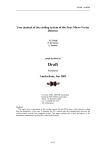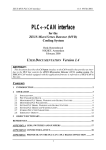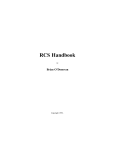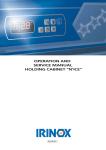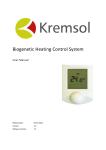Download the manual of EMRI EME_AVR_RAIL
Transcript
EME VD V1.02 Voltage regulator for generators January 2006 Instruction Manual Generator rewinding & repair. Voltage regulator products EME_VD_Manual_V1_31.doc WARNINGS WARNING The system should not be installed, operated, serviced or modified except by qualified personnel who understand the danger of electric shock hazards and have read and understood the user instructions . WARNING Never work on a LIVE generator. Unless there is another person present who can switch of the power supply or stop the engine WARNING Dangerous voltages are present at the voltage regulator board. Accidental contact with live conductors could result in serious electrical shock or electrocution. Disconnect the power source before making repairs, connecting test instruments, or removing or making connections to the voltage regulator or generator. ELECTRICAL HAZARDOUS VOLTAGES DANGEROUS DO NOT OPERATE WHEN NOT FAMILIAR WITH GENERATORS The manual does not cover all technical details of the product. Specifications may be modified by the manufacturer without notice. For further information, the manufacturer should be contacted. Version : 1/25/2006 9:25:00 Page 2 of 19 Generator rewinding & repair. Voltage regulator products EME_VD_Manual_V1_31.doc Table of contents WARNINGS 2 Chapter 1 1.0 1.1 1.2 1.3 Introduction General description AVR Layout Absolute maximum ratings Commissioning information 4 5 6 7 Chapter 2 2.0 2.1 2.2 2.3 2.4 2.5 2.6 2.7 2.8 2.9 Installation and maintenance Connection diagram Running state and LED error codes Power-up routine and diagnose Adjusting and factory settings Special functionality Electrical characteristics Wiring diagram Fault diagnostics (diagrams) Factory settings General installation information 8 9 10 11 12 12 13 14 17 18 Version : 1/25/2006 9:25:00 Page 3 of 19 Generator rewinding & repair. Voltage regulator products EME_VD_Manual_V1_31.doc 1. INTRODUCTION 1.0 General description This manual contains instructions for installing, operating and maintaining the EME VD automatic voltage regulator (AVR). The AVR is specifically designed for railway application according EN 50155 in combination with brushless generators 400 V/50 Hz. It is however very applicable for generator installations where high demands for the accuracy and safety for the generator output are requested. The AVR is equipped with security functions to protect the generator load and equipment from damage or dangerous situations. Critical protections are implemented redundant. The protection circuits as well as the operational status feedback interface contact are tested upon every power up, before the generator is excited by the AVR. The AVR is designed to meet the railway requirements described in the EN 50155:2004, rolling stock. This contains the environmental aspects as well as the electrical aspects such as EMC emission and immunity, supply voltage range, and overvoltage protections. Under normal conditions the AVR is placed inside the generator but installation in cabinets is also possible. The AVR is partly software controlled and deliverable with special functions such as soft voltage recovery at voltage dips upon switched on heavy loads, when using soft prime movers such as a hydraulic motor. The AVR is available for 0-110Vdc as well as 0-24Vdc supply voltage. Version : 1/25/2006 9:25:00 Page 4 of 19 Generator rewinding & repair. Voltage regulator products 1.1 EME_VD_Manual_V1_31.doc AVR Layout The AVR is protected from the environment by an epoxy coating. The bottom of the AVR has a special Protective Earth (PE) connection surface shown as PE in figure 2. Connection terminals are locked by screws and are not exchangeable as a consequence of a coding system. C1 C2 T36 T37 Remove bridge when using external pot. Meter D I PV I t s 2 1 W Ready V Error U Fig 1. Top view AVR (Measurements in mm) Version : 1/25/2006 9:25:00 Page 5 of 19 160mm 140mm 180mm EME VD REG Generator rewinding & repair. Voltage regulator products EME_VD_Manual_V1_31.doc (AVR layout continued) 105m m t s 2 1 W V U 110V 0V K1 J1 UH VH UH’ VH’ C NO 5.5mm 130mm PE Fig 2. Rear view of the AVR (Measurements in mm) 1.2 Absolute maximum ratings Symbol U,V,W Parameter Voltage sensing input Condition < 30 s. 50 Hz. J1, K1 UH, VH UH’, VH’ Field excitation current Supply input Rfield Field resistance Tamb Operating ambient temperature Storage temperature Typical 4 Adc 1- or 3-phase. or two 1-phase dc 400 Hertz @ 100 VUH-VH (rms) @ 230 VUH-VH (rms) 100 % RHD non condensing 95 % RHD non condensing Isolated Isolated Isolated Isolated Isolated - 5% THD < 5 % Tstg NO, C T36, T37 1, 2 0-24 V 0-110V s, t Operational output Clixon input Droop input Electronics supply Electronics supply External Volt adjust Accuracy Min. - Max. 500 Unit Vac 20 5 240 Adc V 4 10 -20 +85 Ohm Ohm ºC -45 +85 ºC 0 18 77 0 Table 1. Absolute maximum ratings Version : 1/25/2006 9:25:00 Page 6 of 19 5A/30V DC Ohm 0.5 Aac 39 Vdc 138 Vdc 5K Ohm 1% Generator rewinding & repair. Voltage regulator products 1.3 EME_VD_Manual_V1_31.doc Commissioning information The system should not be installed, operated, serviced or modified except by qualified personnel who understand the danger of electric shock hazards and have read and understood the user instructions. Defects in the generator or AVR may cause consequential loss. Precautions must be taken to prevent this from occurring. Never work on a LIVE generator. Unless there is another person present who can switch of the power supply or stop the prime mover. Dangerous voltages are present at the voltage regulator board. Accidental contact with live conductors could result in serious electrical shock or electrocution. Disconnect the power source before making repairs, connecting test instruments, or removing or making connections to the voltage regulator. The unit should be installed with respect to the environmental specifications as well as the rules mentioned in the General installation information. For safety reasons the voltage LEVEL potentiometer is best turned completely counter clockwise in order to start at the lowest possible voltage. Version : 1/25/2006 9:25:00 Page 7 of 19 Generator rewinding & repair. Voltage regulator products EME_VD_Manual_V1_31.doc 2. INSTALLATION AND MAINTENANCE For safety reasons the voltage LEVEL potentiometers are best turned completely counter clockwise in order to start at the lowest possible voltage 2.0 Connection diagram For a complete wiring diagram see figure 4 on page 12. T36 T37 EME VD REG T Remove bridge whe n usin g externa l Voltage t rim D I PV S 2 1 W V Rea dy Erro r 110V 0V K1 J1 UH VH UH’ VH’ C T S 2 1 W U V NO U Fig 3. Connectors (top and rear view) Symbol U, V, W 1&2 S&T 0 – 110 V K1 & J1 UH & VH UH’ & VH’ C & NO T36 & T37 Description Voltage sensing input Droop input External connector for remote voltage control External electronic supply AVR field excitation Supply input Supply input Status contact Clixon input Table 2. Connecting diagram Version : 1/25/2006 9:25:00 Page 8 of 19 Notes 0,5 Aac max (Vphase) When used, remove bridge 24 Vdc also available Closed when AVR operational Overtemperature when open Generator rewinding & repair. Voltage regulator products 2.1 EME_VD_Manual_V1_31.doc Running state and LED error codes Important: By removing the 110Vdc (or 24Vdc) power supply, error codes will be lost! To read out the error code, the 110Vdc (or 24Vdc) power supply must remain connected after an error occurred. In order to reset the AVR, remove the 110Vdc (or 24Vdc) power supply for at least 5 seconds. Green LED off: Diagnose fault AVR, AVR not running Green LED on: No diagnose fault, AVR running Red LED on: Fault and error, AVR not running Table 2. LED status and corresponding error codes No. of Blinks Red LED Error Description Green LED off Green LED On Value Time 1 Operational contact selftest failure Undervoltage 380V >5s 2 Supply relais selftest failure Undervoltage 340V >1s 3 Overvoltage selftest failure Overvoltage 420V >5s 4 Error reset selftest failure Overvoltage 440V >1s 5 Overtemperature selftest failure Overvoltage 500V >0,1s 6 Measurement selftest failure Underspeed 45Hz >5s 7 Phase loss selftest failure Overspeed 55Hz > 5s 8 Overtemperature T36/T37 > 5 s 9 Phase loss >0,1 s T36-T37 > 5s Critical Error 10 500V Note: Critical error is either Overvoltage or Overtemperature (hardwired circuits) Version : 1/25/2006 9:25:00 Page 9 of 19 >0,1s Generator rewinding & repair. Voltage regulator products 2.2 EME_VD_Manual_V1_31.doc Power-up and diagnose For a successful self test, a remanent voltage of at least 11 Vac phase-phase and a frequency between 45 and 55Hz have to be present. Power-up self test takes approximately 15 seconds Error blink code Green LED off Ready Solution Replace AVR. 2 Reason Operational contact failure Supply relay failure 3 Over voltage failure Replace AVR. 1 Replace AVR. Green LED on Reason Voltage drop because of too high load Voltage drop because of too high load RPM of prime mover unstable AVR defect RPM of prime mover unstable AVR defect RPM of prime mover unstable AVR defect RPM of prime mover too low Coupling defect RPM of prime mover too high Coupling defect Over temperature Solution Reduce load Check for short circuit Reduce load Reduce RPM Replace AVR Error reset failure Replace AVR. Reduce RPM 4 Replace AVR Temperature failure Replace AVR. Reduce RPM 5 Replace AVR 1 Check sensing wiring . Increase RPM Measurement failure 6 Replace AVR. Replace coupling Phase loss failure Replace AVR. Reduce RPM 7 Replace coupling Check ventilation 8 Clean housing Phase loss Check wiring 9 Short circuit Check short circuit Critical error Reduce RPM 10 Check ventilation Clean housing Replace AVR Note 1: For a successful selftest a minimum remanent voltage of 11V phase-phase has to be present. Table 3. Error codes and solutions Version : 1/25/2006 9:25:00 Page 10 of 19 Generator rewinding & repair. Voltage regulator products 2.3 EME_VD_Manual_V1_31.doc ADJUSTING AND FACTORY SETTINGS When delivered the AVR is ready to use with pre set factory settings. These settings are explained in table 4. It is not advisable to change these settings because changing the factory settings can damage the generator and cause high voltage. Adjusting may only be done by qualified personnel who understand the danger of electric shock hazards and have read and understood the user instructions 100 100 100 100 0 0 0 0 Factory default Turning CW Increase the output voltage Turning CCW Decrease the output voltage Factory default Turning CW Increase the Proportional gain action Turning CCW Decrease the Proportional gain action Factory default Turning CW Increase the Integral action Turning CCW Decrease the Integral action Factory default Turning CW Increase the amount of voltage droop Turning CCW Decrease the amount of voltage droop Voltage setpoint: Adjust the generator output voltage P action setpoint: Adjust the P-action control characteristic I action setpoint: Adjust the I-action control characteristic Droop setpoint: Adjust the voltage droop for parallel operation Table 4. Adjusting AVR setting (note CW=Clock wise CCW=Counter Clock wise) Version : 1/25/2006 9:25:00 Page 11 of 19 Generator rewinding & repair. Voltage regulator products 2.4 EME_VD_Manual_V1_31.doc Special functionality* The AVR has a unique feature of reducing the reference voltage. When a heavy load is switched on and the generator output voltage decreases below 370V, the AVR lowers the reference voltage to 370V. When the generator voltage is equal to the AVR reference voltage again, the AVR builds up to the normal voltage output threshold level again. This feature prevents the generator from producing a voltage overshoot due to heavy load switches in combination with an over-magnetized generator. Voltage reference lowering due to heavy load change * Not implemented on 24V version 2.5 Electrical characteristics Parameter Sensing voltage input Supply input UH, VH, UH’, VH’ Electronics supply 0-110Vdc / 0-24Vdc Field excitation current Field resistance Voltage setpoint range Operational contact Ambient temperature Storage temperature EME VD 110Vdc AVR 3 x 400 V – 50 Hz 85V – 100Vac, 100 – 400 Hz EME VD 24Vdc AVR 3 x 400 V – 50 Hz 85V – 100Vac, 100 – 400 Hz 77 – 138 Vdc 18 – 39 Vdc 3,7 A 6 – 10 L ± 5% 30V / 5Adc -20ºC to +70ºC, non condensing -30ºC to +55ºC, non condensing 3,7 A 6 – 10 L ± 5% 30V / 5Adc -20ºC to +70ºC, non condensing -30ºC to +55ºC, non condensing Stresses above those listed under “Absolute Maximum Ratings” may cause permanent damage to the device. This is a stress rating only and functional operation of the device at those or any other conditions above those indicated in the operation listings of this specification is not implied. Exposure to maximum rating conditions for extended periods may affect device reliability and lifetime. Version : 1/25/2006 9:25:00 Page 12 of 19 Generator rewinding & repair. Voltage regulator products 2.6 EME_VD_Manual_V1_31.doc Wiring diagram T36 T3 7 V P I D volta ge p-action stability EME VD REG i-action s tabilty droop R emove b rid ge when u sin g external Voltage trim D I PV Ready Error Operat io nal T S 2 W 1 V U 110V 0V K1 J1 UH VH UH’ VH’ C NO Volt trim 10 kOhm Operat io nal N P1 V U T S1 OPTIONAL DROOPKIT W GENERATOR OUTPUT, ROTATION CLOCKWISE Enabl e STATOR ROTOR Fig 4. Wiring Version : 1/25/2006 9:25:00 Page 13 of 19 EXCITER FI ELD Generator rewinding & repair. Voltage regulator products 2.7 Fault diagnoses 420V Overvoltage 380V Undervoltage Version : 1/25/2006 9:25:00 Page 14 of 19 EME_VD_Manual_V1_31.doc Generator rewinding & repair. Voltage regulator products 440V Overvoltage 340V Undervoltage: 500V overvoltage: Version : 1/25/2006 9:25:00 Page 15 of 19 EME_VD_Manual_V1_31.doc Generator rewinding & repair. Voltage regulator products Overspeed Underspeed Overtemperature Version : 1/25/2006 9:25:00 Page 16 of 19 EME_VD_Manual_V1_31.doc Generator rewinding & repair. Voltage regulator products EME_VD_Manual_V1_31.doc Phase loss 2.8 Factory settings After service or repair the AVR is re-adjusted to factory settings which are: Parameter Value Unit Output Voltage 400 V Under speed frequency 45 Hz Over speed frequency 55 Hz Droop 0 V Version : 1/25/2006 9:25:00 Page 17 of 19 Generator rewinding & repair. Voltage regulator products 2.9 EME_VD_Manual_V1_31.doc General installation information Absolute Maximum Ratings - The Absolute Maximum Ratings are those limits for the device that, if exceeded, will likely damage the device. Exceeding the absolute maximum ratings voids any warranty and/or guarantee. Mounting Mounting of the product should be done in such a way that the absolute maximum ambient temperature rating of the product will never be exceeded. Mounting of the product should be done in such a way that maximum cooling (direction of cooling ribs and direction of airflow) is achieved. Mounting of the product should be done in such a way that no humid air can flow through the product or condensation occurs. Mounting of the product should be done in such a way that dust or other materials or residue will not remain in or on the product. Mounting of the product should be done in such a way that the maximum vibration is not exceeded. Mounting of the product should be done in such a way that personal contact with persons is impossible. Wiring - Diameter size of the wiring should be enough to carry the expected current. Wire insulation should be enough to withstand the expected operating voltages and temperatures. To improve EMC emission and immunity, care should be taken for the lay out of the wiring. This in respect to all wiring in the installation. Keep current carrying wires as short as possible. Keep wires carrying a total sum of zero Ampere close to each other, or in one single cable. E.g. U, V, W or F+ and F-, or Phase and neutral, X1 and X2. Avoid current carrying conductors next to sensing or control wiring. Especially current controlled by SCR’s or PWM controlled transistors. If sensitive sensing signal cables need to be laid across distance along other cabling, shielded cable is preferred. Keep the shield as long as possible and the wiring outside the shield as short as possible. Do not solder or shrink the shield to a regular wire. Connect the original shield to ground at one side with an as large as possible contact surface. Version : 1/25/2006 9:25:00 Page 18 of 19 Generator rewinding & repair. Voltage regulator products EME_VD_Manual_V1_31.doc Additional installation information - - - - When the product is supplied by means of a transformer, it should never be an autotransformer. Auto-transformers react as voltage sweep up coil and may cause high voltage peaks. Standard fit capacitors or over-voltage suppressers across F+ and F- or exciter field terminals inside the generator should be removed. When the product is supplied by means of a transformer, it should be able to carry at least the maximum expected current. Advisable is, to have a transformer which can carry twice the maximum expected current. Inductive loads make voltage sacks and peeks into the secondary voltage of a transformer, from which the device may malfunction. It is not recommended to apply switches in dc outputs. It is preferred to use switches in the ac supply inputs of devices. In case it is unavoidable to have switches in the dc output of a device, action must be taken to avoid over voltage damage to the device due to contact arcing. Use a voltage suppressor across the output. It is not recommended to apply switches or fuses in the sensing lines. Defects can cause high voltage situations due to over-excitation. When using a step down transformer in medium or high voltage generators, the transformer should be three phase (if three phase sensing), and the transformer should be suitable for acting as a sensing transformer. If the transformer is unloaded, connect a resistor to avoid voltage waveform distortion. The phase relation from the generator to the AVR is important. Also when voltage transformers and/ or current transformers are installed. When using a step down or insulation transformer in the droop circuit, phase relation from the generator to the AVR is important. CT’s wiring, connected to the AVR should never be grounded. Always disconnect electronic products, circuits and people before checking the insulation resistance (Megger check). Due to differences in generators impedance’s, EMC behavior is not predictable. Therefore the commissioner / installer should be aware of proper and correct installation. Large, highly inductive, exciter stator windings can cause destructive high voltage peaks. Adding a resistor from 10 to 20 times the exciter stator field resistance reduces voltage spikes. If necessary filter can be fitted additionally. (e.g. snubber, RC-network) Upon problems during commissioning, faulty behavior or defects in the generator, consult the fault finding manual at our web site Some advises may be overdone or seem extraordinary, but since the electrical rules are the same everywhere, these advises are given. Version : 1/25/2006 9:25:00 Page 19 of 19



















